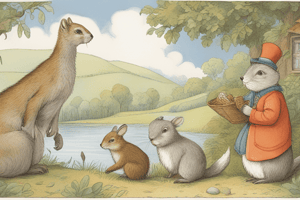Podcast
Questions and Answers
Give an example of a predator that lives in groups and cooperates to locate, capture, and defend prey.
Give an example of a predator that lives in groups and cooperates to locate, capture, and defend prey.
Lions
How do wild animals communicate with each other?
How do wild animals communicate with each other?
Using a variety of signals, including vocalizations, body language, and scent marking.
Describe an adaptation of an animal well-suited for the dense vegetation of forests.
Describe an adaptation of an animal well-suited for the dense vegetation of forests.
Camouflage
What type of adaptations do aquatic predators like crocodiles and otters possess?
What type of adaptations do aquatic predators like crocodiles and otters possess?
Give an example of a reproductive adaptation that animals have evolved.
Give an example of a reproductive adaptation that animals have evolved.
What is a key role that predators play in ecosystems?
What is a key role that predators play in ecosystems?
Describe the hunting behavior of lions in the African savanna.
Describe the hunting behavior of lions in the African savanna.
What is the preferred prey of great white sharks?
What is the preferred prey of great white sharks?
How do wolves typically hunt?
How do wolves typically hunt?
What influences the behavior of wild animals?
What influences the behavior of wild animals?
Flashcards are hidden until you start studying
Study Notes
Wild Animals: Predators, Behavior, Habitats, Adaptations
Wild animals occupy a diverse and fascinating world, playing crucial roles in their ecosystems. As we explore the realm of wild predators, their behavior, habitats, and adaptations, we gain a deeper appreciation for the complexity and interconnectedness of nature.
Predators
Predators form the backbone of food webs, controlling populations and maintaining balance within ecosystems. Some well-known examples of wild animal predators include:
- Lions: Prideful hunters of the African savanna, lions rely on teamwork for successful hunts. They often target large herbivores like zebras and antelopes.
- Great White Sharks: Oceanic masters of stealth, great white sharks breach the surface to catch seals and other marine mammals.
- Bears: Predatory bears, like grizzlies and brown bears, hunt a variety of prey, including fish, rodents, and even larger mammals.
- Wolves: Highly social pack animals, wolves hunt in coordinated groups, targeting a wide range of prey.
Behavior
The behavior of wild animals is influenced by factors such as their environment, social structure, and genetic makeup.
- Hunting techniques: Animals like tigers use a combination of stalking and ambush to capture prey, while hunting birds, like falcons and eagles, rely on their sharp vision and agility to capture prey in mid-flight.
- Social structure: Some predators, like lions and wolves, live in groups and cooperate to locate, capture, and defend prey, while others like lynx and mountain lions are more solitary creatures.
- Communication: Wild animals communicate with each other using a variety of signals, including vocalizations, body language, and scent marking.
Habitats
Wild animals live in a wide variety of ecosystems, from forests to grasslands to oceans.
- Forests: Animals like jaguars and leopards are well-adapted to the dense vegetation of forests, where they use their camouflage to stalk prey.
- Tundra: Polar bears and wolverines are adapted to the harsh, icy conditions of the tundra, where they rely on their thick fur and powerful claws to survive.
- Deserts: Desert animals, like fennec foxes and dromedary camels, have evolved adaptations to cope with extreme temperatures and scarce water resources.
- Rivers and Lakes: Aquatic predators like crocodiles, beavers, and otters thrive in wet environments, where they utilize their unique adaptations to capture prey.
Adaptations
Wild animals have evolved a diverse array of adaptations to suit their environments and lifestyles.
- Physical adaptations: These include features like sharp claws and teeth, streamlined bodies, and specialized sensory organs, like the eagle's sharp talons and the shark's electroreceptors, which help them detect prey.
- Behavioral adaptations: Animals exhibit a variety of behaviors to avoid predators, such as camouflage, mimicry, and cooperative defense.
- Reproductive adaptations: Many animals have evolved specialized reproductive strategies to increase the chances of their offspring's survival, including the production of multiple offspring and the use of parental care.
Wild animals are not just a fascinating topic of study; they are essential to maintaining healthy ecosystems and supporting biodiversity. By understanding the complex relationships between predators, behavior, habitats, and adaptations, we can better appreciate the importance of conservation efforts and work to preserve the wildness that remains within our planet.
Studying That Suits You
Use AI to generate personalized quizzes and flashcards to suit your learning preferences.




